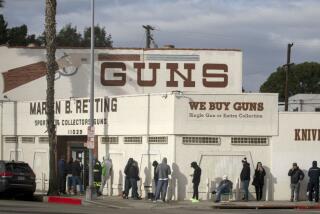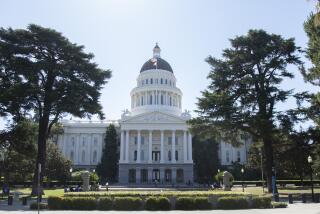Bill Proposes ‘Fingerprinting’ of Firearms
SACRAMENTO — SACRAMENTO -- A legislative advocate of tighter gun controls has introduced a bill requiring that the “ballistic fingerprint” of the hundreds of thousands of handguns, rifles and shotguns sold in California be registered with state Department of Justice.
The bill, SB 35, by Sen. Jack Scott (D-Altadena) would create a state database operated by the Department of Justice that could be tapped by police to match the unique characteristics of bullets and cartridges with firearms used in crimes.
Scott conceded that ballistic fingerprinting is not a perfect crime-fighting technique, but said that California, as what he called the No. 1 state “in population and gun sales,” should not wait for the federal government to devise a national system.
“I believe that the state of California ought to take the lead on this issue,” he told reporters. “This is one more tool in the arsenal of law enforcement.”
The bill, introduced Monday, includes no method of financing the program, but Scott said he may amend it to include a fee on gun purchases.
Ballistic fingerprinting is the shorthand description of the distinctive marks left on every bullet fired by a rifle or handgun. The marks are formed on the projectile by the spiraling grooves in the gun bore that give the bullet its spin. Also, an indentation is made when the firing pin strikes the cartridge. Like fingerprints, each mark is unique to the gun that fires the bullet.
In California, the task may be daunting. Last year, there were 354,202 sales of new and used handguns and long guns, according to the Justice Department. In 1993, a record 642,197 guns were sold.
Organizations of gun owners and manufacturers attacked the bill, questioning the accuracy of using ballistics to identify the owner or owners of a gun used in a crime.
“Do we really know the state of the art? Is it reliable? We know it will be expensive, but will it be worth the cost?” asked Jerry Upholt of the California Rifle and Pistol Assn.
The National Shooting Sports Foundation, which represents major firearm manufacturers, challenged the accuracy of ballistic fingerprinting in establishing a law-enforcement registry.
“We support the use of ballistic imaging in a forensic way in the prosecution of criminals,” a foundation spokesman said. But, he added, “our industry position is there are a whole lot of questions yet to be answered.”
For example, he said, when a gun is new it will produce a certain set of distinctive markings on a bullet and casing. But as the firearm becomes worn from use, he said, the markings change and no longer are identical to the original ones.
Andrew Arulanandam, spokesman for the National Rifle Assn., which opposes use of ballistic imaging, said New York and Maryland have had similar systems for years.
In those states, he said, the systems have “resulted in zero prosecutions.” He said firearm fingerprints can be altered by running a file down the bore or changing the firing pin. “Any such actions would render the database useless,” he said.
But Scott, an author of many gun-control bills, contends the NRA has “opposed almost every sensible gun safety bill that I can think of.” He said the group’s credibility was “open to question.” He also noted that the federal Bureau of Alcohol, Tobacco and Firearms supports the use of ballistic fingerprinting.
Atty. Gen. Bill Lockyer, whose department has made a preliminary examination of ballistic imaging and questioned its effectiveness, supports the concept of ballistic imaging but prefers that it be handled by the federal government, said a spokeswoman. She said Lockyer has no position on the bill.
Because of state budget constraints, Scott said his proposal probably would need to be implemented over several years, but as a first step gun makers would be required to fire a gun before it was sold and keep an electronic record of the ballistic characteristics of the firearm and bullet for law enforcement.
More to Read
Sign up for Essential California
The most important California stories and recommendations in your inbox every morning.
You may occasionally receive promotional content from the Los Angeles Times.










